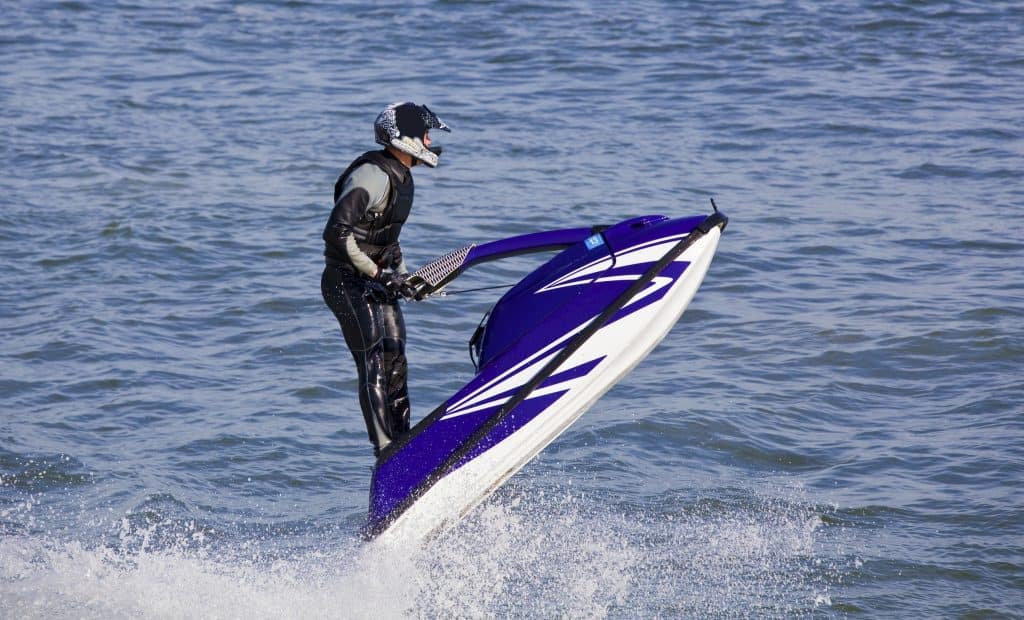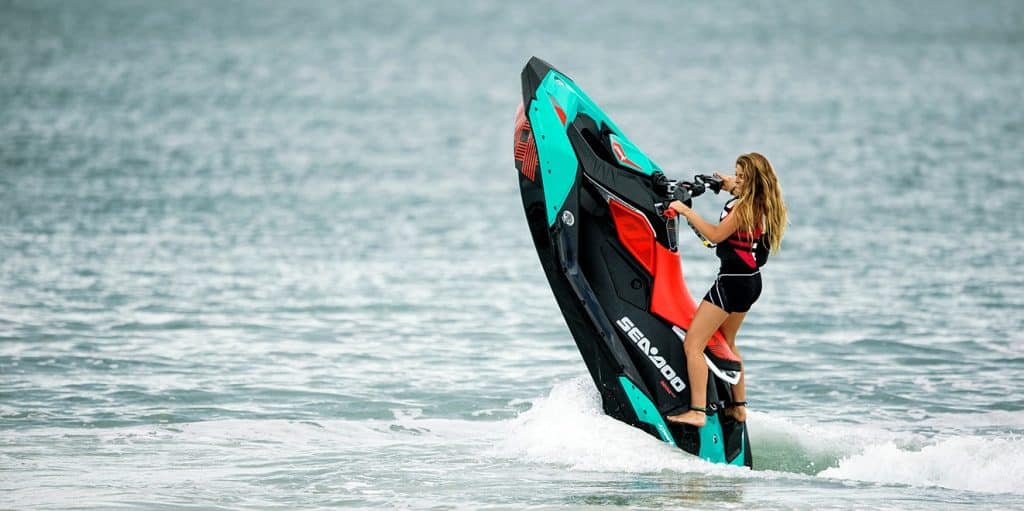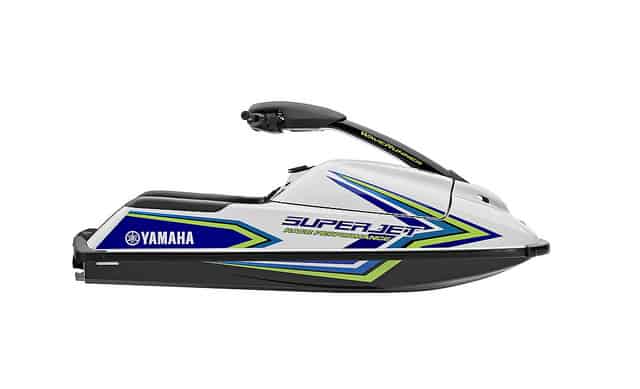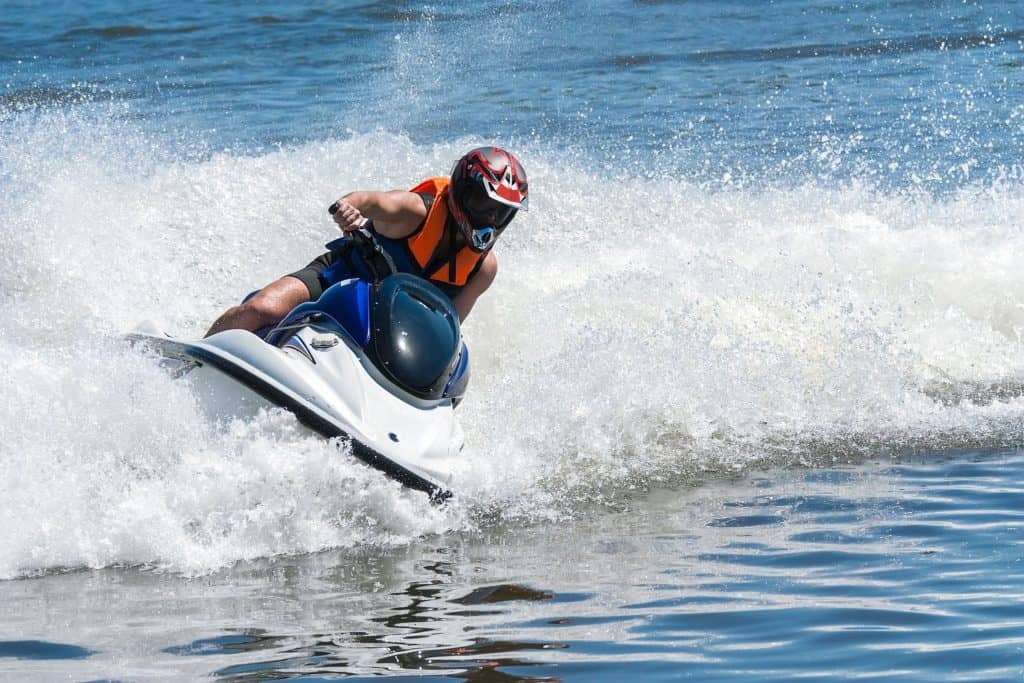Any jet ski could be considered a high-performance machine. Think about it. They are all mini boats that are capable of speeds of about 50 miles per hour, and many of them can go much faster than that. They can make sharp turns, and in the hands of a professional, they have precise acceleration and deceleration.
Jet skis are all fairly light weight yet sturdy. They are all made by manufacturers with good reputations and decades of experience. But with all products, some stand out above the others when it comes to certain uses.
Performance jet skis are jet skis which are made with the specific purpose of winning races. Fishing, tow sports, and going on adventures to islands are all great activities that can be done with any other model, but these models are all about competing and winning.
Let’s take a look at what the pros use, and what makes them such winning machines.

Types of Jet Ski Races
Jet skis are built to go fast, so it only makes sense that people want to see who can go the fastest. Just like with any other type of racing, there are different types of jet ski races. Think about track competitions. There are 100 meter, the 500 meter, the 800 meter, and more, up 10,000 meter races.
Depending on the organization in which a racer competes, there are different types of competitions. These can include races for only stand-up models, races for only sit-down models, and even freestyle competitions which are not races, but trick contests.
Two common types of races are sprints and enduros. Again, there may be slight differences between different racing organizations, but these types of races are similar throughout all of them. As the names suggest, sprints are shorter, faster races, while enduro races take longer to complete.
In the Aqua Cross, or AquaX league, sprint races are only for stand-up type models and sit-down models with passenger capacities of one. They usually take anywhere from ten to fifteen minutes to complete.
In the AquaX enduro races, riders may use any model of sit-down jet ski built for two or more people. These races generally take anywhere from thirty to forty minutes to complete.
Choosing The Right Model For The Right Use
There are all kinds of jet skis that you can buy. Some are big, some are small. Some are made specifically for fishing or for tow sports like water skiing, and some are made with the express purpose of going faster than the rest.
So, with so many different models to choose from, how do you know which ones are best for racing? Well luckily, the manufacturers make it pretty clear which of their models they intend to be used in competitions.
Using the two general race types, we can take a look at and break down some of these models. We’ll start with the models that are allowed in sprint competitions.
Sea-Doo Spark

AquaX specifically names the Sea-Doo Spark as an acceptable choice for sprint competitions. The Spark is made to be light and easy to handle, which is what makes it a good choice for sprints. It weighs just a little over 400 pounds, about 422 to be exact.
It is 110 inches long, 42 inches tall, and 46 inches wide. The weight and small size make it a master when it comes to maneuverability, which is a big help in this type of race. These factors, combined with the engine, make it a formidable machine.
The engine that he Spark sports is the ROTAX 900 HO ACE (which stands for Advanced Combustion Efficiency). It has 899 cc of displacement, and what makes Sea-Doos different from Yamahas and Kawasakis is the cooling system.
Yamaha and Kawasaki engines both employ open loop cooling systems. This is the case with almost all watercraft. But Sea-Doo engines feature a closed loop cooling system. Ultimately, it comes down to a matter of opinion when deciding which system is better, but it is certainly one thing that makes Sea-Doos different.
Yamaha WaveRunner EXR
Models from Yamaha’s EX series are also on the list of approved vehicles for sprint races. Yamaha has one of, if not the best, reputations when it comes to producing quality jet skis. They are known to outlast and in many cases out perform the competition.
The WaveRunner EXR is no exception to the excellence that Yamaha provides.
At 540 pounds, it does weigh a bit more than the Spark. It is 123.6 inches long, 45.3 inches tall, and 44.5 inches wide, making it a bit larger than the Spark is most regards as well.
It has a 3-cylinder, 4-stroke TR-1 High Output Yamaha Marine Engine, with 1049 cc of displacement. This powerful engine really gives the EXR some kick.
Another feature of the EXR, and all WaveRunners made by Yamaha, is that they have automatic bilge pumps built in. Of course, jet skis are made to go on the water, so they are designed to keep water out of where it does not belong pretty well.
But anything can happen and knowing that the bilge pump is there adds a lot of peace of mind if the engine compartment does start leaking.
All in all, the EXR is a powerful machine in a compact package that could be a good choice for anyone looking to race small and agile jet skis.
Kawasaki Jet Ski SX-R
Kawasaki is the third of the big three manufacturers of these racing water machines. While jet ski has come to be used as the general term to refer to any similar watercraft, Jet Ski is actually the brand and model of these watercraft manufactured by the company Kawasaki.
Kawasaki has been in the jet ski business longer than any other manufacturer, and this model has its roots where the company had its start in the market. Kawasaki began manufacturing stand-up type jet skis in the early 1970s, and with this model, it is one of only two companies that still makes stand-up models.
The Jet Ski SX-R has one of the most impressive sizes to power ratios of any model in production. It weighs 551 pounds, including all necessary fluids for operation and a nearly full tank of gas. It is 104.5 inches long, 33 inches tall, and 30 inches wide.
The engine it features is a 4-stroke, DOHC, four valves per cylinder, 4-cylinder inline, offering 1,498 cc of displacement and 957 pounds of thrust.
The powerful engine, small size, and maneuverability that it is capable of make it an attractive option if a rider is interested in a stand-up model.
Yamaha Superjet

As mentioned above, only two stand-up models are still currently in production. This is the other one.
The Superjet is smaller and more conservative compared to the Jet Ski SX-R. It has a dry weight (meaning it does not have fuel or liquids added) of 306 pounds. It is 88 inches long, 26 inches tall, and about 27 inches wide.
The engine it has is a 2-cylinder, 2-stroke Yamaha Marine Engine. It provides 701 cc of displacement. There are a few differences between 2-stroke and 4-stroke engines.
The main differences are that 2-stroke engines are much lighter, they require a pre-mixture of oil and fuel, and they create more torque at a higher rpm while 4-strokes create more power at a lower rpm. 4-stroke engines generally last longer as well.
When it comes to choosing between a 2-stroke and a 4-stroke engine, it largely comes down to personal preference.
The Yamaha Superjet may be a good choice for someone wanting a stand-up model that is a little smaller than the SX-R.
Now we can look at some models that are good for racing in enduro competitions. The rules that AquaX has are a little more lenient when it comes to this type of race. You can race any model as long as it has a seating capacity of two or more. But of course, some models are going to be better suited for these races.
Sea-Doo GTR 230
The Sea-Doo GTR 230 is a good place to start. It is the cheapest and most simple model in the performance series of Sea-Doo, but it is not a simple machine.
Its dry weight is 807 pounds. Right away we can see that these models are going to be much larger than the smaller ones used in sprint races. The GTR 230 is 132.6 inches long, 44 inches tall, and 48.5 inches wide.
Its engine is a 1500 HO ACE, which offers 1,494 cc of displacement and also features a closed loop cooling system.
This is a powerful model but is still on the more affordable side of larger, high-performance racing models.
Sea-Doo RXP-X 300
This is the model that Sea-Doo boasts is the ultimate racing watercraft.
The RXP-X’s dry weight is 847 pounds. It is 130.6 inches long, 45.3 inches tall, and 48.3 inches wide. It weighs a bit more than the GTR 230, but it is actually a little smaller in two dimensions.
The engine has is a 1630 ACE, which offers 1,630 cc of displacement and 300 horsepower. This powerful engine makes the RXP-X capable of impressive speeds and a good choice for racers with a little more money to spend on a watercraft.
Kawasaki Jet Ski Ultra LX
The Jet Ski Ultra LX is an impressive machine but is still on the lower end of the spectrum as far as performance models made by Kawasaki are concerned.
It weighs about 933 pounds, which includes fuel and other necessary liquids. It is 132.7 inches long, 45.3 inches tall, and 47 inches wide.
The engine it is equipped with is a 4-stroke, DOHC, four valves per cylinder, 4-cylinder inline, with 1,498 cc of displacement and 957 pounds of thrust.
These specs are no doubt impressive, but Kawasaki still has more to offer.
Kawasaki Jet Ski Ultra 310LX
This is the top of the line for jet skis made by Kawasaki, and is one of the most powerful (and pricey) models manufactured today.
It weighs 1,074 pounds with fuel and other liquids. It is 132.7 inches long, 49.4 inches tall, and 47 inches long. We have really come a long way from the sizes of the sprinting models!
Its engine is a Supercharged and intercooled, 4-stroke, DOHC, four valves per cylinder, inline 4-cylinder, which offers displacement of 1,498 cc and 310 horsepower.
This is truly a machine to be reckoned with. It is easily capable of speeds of over 60 miles per hour, and some even claim to take them higher than 70 miles per hour.
Yamaha WaveRunner VXR
Of course, Yamaha is not getting left in the dust of the competition. The VXR is on the starting end for larger high-performance racing models by Yamaha.
This watercraft has a dry weight of 739 pounds. It is about 132 inches long, 47 inches tall, and 48 inches wide.
The engine on this model is a 4-cylinder, 4-stroke, 1.8 Liter High Output Yamaha Marine Engine. The displacement is 1,812 cc, and this model is capable of speeds of up to just a little under 70 miles per hour! Yamaha is off to a good start in high performance.
Yamaha WaveRunner GP 1800R
This is the model that Yamaha advertises as a proven winner, and for good reason. It definitely is on the top end of racing models produced by Yamaha.
The GP 1800R has a dry weight of 769 pounds. It is about 132 inches long, 47 inches tall, and 48 inches wide. It is the same size as the VXR and only weighs 30 pounds more.
The engine the GP 1800R has is a Supercharged 4-cylinder, 4-stroke, Super Vortex High Output Yamaha Marine Engine. The displacement is 1,812 cc. The top speed is around 70 miles per hour, but some riders claim to have taken it to nearly 80 miles per hour. It accelerates from 0 to 30 miles per hour in under two seconds.
This watercraft is truly Yamaha’s top of the line.
All information for Yamaha models was found here, information for Sea-Doo models found here, and Kawasaki models here.

The Favorite Models of The Pros
So, which model is the best? All of the models we have looked at are winners in their own right, but to know which ones win the most races we can look at the riders who compete.
Using the AquaX world rider rankings, we can see which models the athletes use to rank highly.
The top three overall ranked riders in the world right now, Eric Francis, Brian Baldwin, and Chris Macclugage all use the Yamaha GP 1800 to compete.
The rider ranked fourth overall, Erminio Iantosca, competes using the Sea-Doo RXT-X 300.
The fifth overall ranked rider, Chris Saxon, uses a Yamaha FX SVHO to compete in races. The sixth and seventh-ranked riders, Thomas Favolini and Eric Lagopoulos, both use the Yamaha GP 1800.
In Eighth place in the ranking is Joseph Harvey, the highest ranked rider to use a Kawasaki. His watercraft of choice is the Jet Ski Ultra 310R.
In ninth and tenth place we have Nicolas Rius and Mike Klippenstein, both of whom compete using the Yamaha GP 1800. It looks like there could be a clear winner.
Out of the 52 ranked riders on AquaX’s list, 39 use some kind of model produced by Yamaha, 8 use a model of Sea-Doo, and 5 use a model produced by Kawasaki.
The fact that there is representation from all three of the big three manufacturers indicates that the machine does not make all the difference. The riders need to have skill and talent to do well. But the fact that the vast majority of riders use Yamaha seems to indicate that Yamaha produces the best quality watercraft.
Ranking list found here.
The Final Verdict
Obviously, the outcome of a race depends more on the riders than anything else. I could get on the fastest jet ski in the world, but I would most likely not win against a professional racer using even the lowest quality jet ski.
That being said, the Yamaha GP 1800 seems to be the biggest winner out of all of these models.
